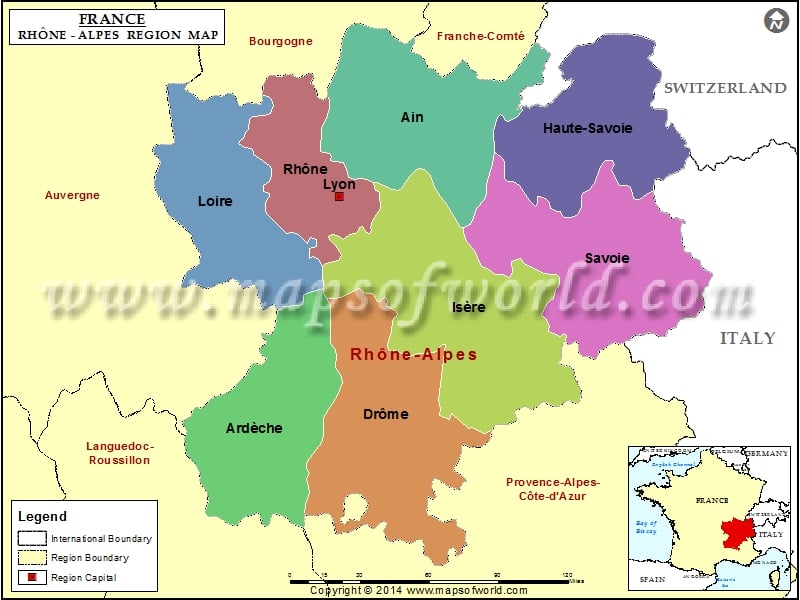Rhône-Alpes Map

General Overview
The Rhone-Alpes region is the second largest region in France. It has grown over the years, centered on the second city of France (in terms of size)– Lyon. The other important cities in this region are St. Etienne and Grenoble. The region also covers the area that has grown up around Lake Geneva located in Switzerland.
The region shares international borders with Switzerland and Italy. It is a diverse area. Industries are well developed here. Rhone-Alpes region has remained a leading hub of raw materials and manufactured goods. Apart from this, it ranks first in the production of French energy and second in electrical industry, chemicals, and mechanical construction.
Weather
The weather of the Rhone-Alpes region is predominantly continental, though, some elements of the Mediterranean climate are also seen. The diverse topography exercises considerable influence on the weather. Summers are hot and humid. The winters are quite cold– especially the regions near the Alps Mountains. Rainfall is plentiful, though the region experiences a number of sunny days. Avariety of influences has created different climes in the area.
Geography
The geography of the Rhone-Alpes region of France is highly diverse. The region is situated in the south-east of the country. The Alpine mountains lie to the east. Mont Blanc is the most notable peak here while the Verdon gorge remains the deepest gorge in Europe. The major geographical feature of the area is the plateau called the Central Massif. It is located in south-central France and exercises considerable influence on the climate. The plains of Lakes Geneva and Annecy are the other important geographical features.
Rivers Rhone and Saone flow through the region. Most of the region is made up of valleys carved out by these two rivers. A series of deep valleys separate the Alps from the Central Massif. The Rhone River valley is the shortest route connecting north and the south without circumventing the Alps.
History
The earliest settlements in the Rhone-Alpes region were founded by the Gauls or Celts. The city of Lyon was founded by them. The region was occupied by the Romans under Julius Caesar and the area became an important part of the Roman Empire. Lyon continued to remain a major city of the Roman Empire. Subsequently, the area came under the control of the Lords of Vienne and then the Dukes of Burgundy. The region formally became a part of France in the 17th century.
Language
French is the official language of the area though Italian, Swiss, and English are also spoken.
Tourism
The diverse topography ranging from the ski resorts of Alps, the shores of the Lake Geneva, and the breathtaking Rhone Valley have helped in the development of tourism in the region. Wine tasting has flourished in the vineyards of the Rhone Valley, while skiing is a much favored activity in the Alps. Tourists interested in historic remains find plenty to explore in the city of Lyon, Vienne, and Bresse. Winter sports including hiking have developed in many areas while world class spas attract celebrities from all over the world.
References:
Encyclopaedia Britannica
Wikitravel
Eupedia- Travel Guide